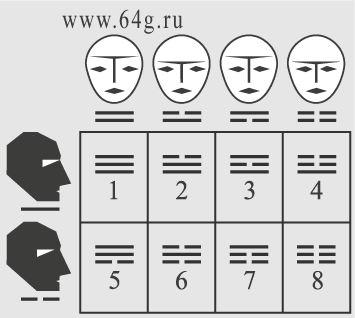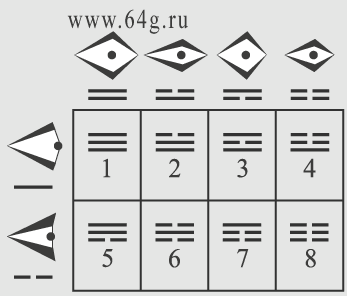-
-
Basic parameters of human personality in physiognomic sphere of individuality
are shapes of a nose, but also eyes in a context of physiognomy too mean
psychological features of human individuality.
Nose is projection of personal individuality, or otherwise to tell individual
ego of personality, and eyes express interrelations of personality with
individualities of other people. Accordingly horizontal and vertical coordinates
of eyes in faces of people mean potential and kinetic correlations of individual
ego with individualities of people.
Coordinates of eyes concerning horizontal axis of measurements in full-face are
important, and other coordinates are actually caused by shapes of nose bridge
and eyebrows, that is shown in the table.
 |
At the top there are physiognomic images or drawings
which designate vertical facial coordinates that corresponds to
different distances from eyes to eyebrows, and also corresponds to top
lines in trigrams of the canon i-jing in cells of the table. If lines on top positions are entire then vertical distance between eyes and eyebrows is long, and if lines are break then distance is short. And also physiognomic drawings at the top designate horizontal coordinates of eyes according to frontal facial perspective in full-face that corresponds to different distances between eyes, and corresponds to middle lines in trigrams i-jing in cells of the table. If lines on middle positions are entire then horizontal distance between eyes is wide, and if lines are break then distance is narrow. |
At the left physiognomic drawings designating horizontal coordinates of eyes
according to lateral facial perspective in profile that corresponds to the
expressed and not expressed locations of eyes concerning nose bridge, and also
corresponds to bottom lines in Ba Gua of i-jing in cells of the table.
If line on bottom position is entire then horizontal location of eyes in profile
is expressed, and if line is break then location is not expressed.
According to symbols of the canon i-jing in the table it is possible to analyze
correlations of potential and kinetic parameters of individuality in mutual
relationships with people.
For example, eyes on the human face in view of physiognomy correspond to the
sixth trigram of i-jing.
In this case significant potential tendencies of a mutual unification of people
or otherwise tell public unity cannot to be actual because kinetic aspirations
to unification is insignificant, that corresponds to geometrical coordinates
according to which the distance between eyes is wide but position concerning
nose bridge is not expressed, namely eyes are widely placed and deeply located.
And also according to short vertical distance between eyes and eyebrows there is
an impression that absence of actual unification of personal individuality with
individualities of people is non-realized psychological lack of the person.
Or if physiognomy of eyes on the human face corresponds to the third trigram of
the canon u-jing then insignificant potential tendencies of mutual unification
of people do not allow to realize significant kinetic aspiration to unification,
that corresponds to narrow distance between eyes and to the expressed location
of eyes concerning nose bridge. But according to the long vertical distance from
eyes to eyebrows there is an impression that unification with individualities of
people is actually realized psychological feature of the person.
Also by means of symbols of the canon i-jing in a context of physiognomy it is
possible to consider not only geometrical coordinates of eyes in faces of
people, but also shapes of vertical and horizontal sizes, that is shown in the
following table.
 |
Above symbolical drawings designate shapes of eyes
concerning vertical axis of measurements, that corresponds to top lines
in Ba Gua of i-jing in cells of the table. If lines on top positions are entire then vertical sizes of eyes are big, and if lines are break then sizes are small. And also symbolical drawings above designate sizes of eyes concerning horizontal axis of measurements in full-face, that corresponds to middle lines in trigrams of i-jing in cells of the table. If lines on middle positions are entire then horizontal sizes of eyes according to frontal perspective of a face are big, and if lines are break then shapes are small. |
-
At the left symbolical drawings designate shapes of eyes concerning
horizontal axis of facial measurements in profile, that corresponds to bottom
lines in symbols of i-jing in cells of the table.
If lines on bottom positions are entire then horizontal sizes of eyes according
to lateral facial perspective in profile are expressed, and if lines are broken
then shapes of horizontal sizes in half-face are not expressed.
Horizontal shapes of eyes in profile are interconnected with vertical sizes, as
if eyes in profile or half-face are expressed then eyelids can be widely open
that increases possible vertical sizes of eyeballs. And if eyes in profile are
not expressed then eyelids can be open less wide, that reduces possible vertical
sizes of eyeballs, that is necessary to consider during visual analyses of human
faces in a context of physiognomy.
During visual geometrical measurements of vertical shapes it is necessary to
consider emotions of sad or joyful expressions of eyes, that is caused by
half-closed or half-opened outlines of eyelids, namely it is necessary to
measure sizes of eyes concerning vertical axis of facial measurements in quiet
emotional conditions of people.
The detailed information about emotions and expressions of eyes in a context of
physiognomy of human faces look on pages of this website in sections which have
names: concept of the canon of changes
and emotional types.
According to physiognomic drawings of eyes and symbols of the canon i-jing in the
shown table it is possible to analyze impressions of people about correlations
of potential and kinetic parameters of human individuality.
For example, if eyes on the human face correspond to the sixth trigram of i-jing
then it seems to people that significant potential tendencies of mutual
unification with such person cannot be actual because kinetic desire of
unification is insignificant, that corresponds to the wide sizes of eyes
according to horizontal measurements in full-face and not expressed eyeballs in
profile. And also according to small vertical sizes of eyes there is an
impression that actual unification with individualities of people is undesirable
to the person.
In a similar way it is possible to analyze eyes in faces of people, or otherwise
to tell geometrical coordinates eye sizes, and it is possible to interpret
meanings of potential and kinetic psychological features of individualities in
relationships and mutual perception of people in a context of physiognomy. And
also it is possible to consider psychological meanings of geometrical shapes of
human eyes not only in a context of physiognomy, but also in view of stylistic
facial design and cosmetic make-up of female faces, namely in view of aesthetic
art on visual correction of psychological images in faces of women.
For example, if eyes of the woman has small sizes concerning vertical axis of
measurements then it is impossible by means of cosmetics and visual make-up to
increase eyes in full-face concerning horizontal axis. As such stylistic design
will make impression of psychological contradictions which are caused by
non-comparable sizes of vertical and horizontal measurements, and by
corresponding incommensurable correlations of potential and kinetic features of
female individuality in mutual relations with people.
Or if distance between eyes on the face of woman according to coordinates of
facial measurements in full-face is wide then in this case too it is impossible
to increase in addition horizontal sizes of eyes by means of make-up, but it is
possible to apply methods of stylistic design as a result of which distance
between eyes will seem less wide. Namely it is possible to create a cosmetic
make-up which will correct geometrical coordinates of eyes on the face of woman,
and will correct psychological impressions which arise at people in mutual
relations with the woman.
It can be important for professional stylists and facial designers who consider
art of stylistic design and cosmetic make-up of eyes as complex aesthetic skill
for visual transformation of psychological images and artistic appearances of
female faces. Or can be important for teachers and organizers of training
courses for visual stylists and facial designers who plan to be engaged in
professional stylistic make-up of eyes and female faces in prestigious beauty
shops and beauty-style consulting rooms. And also the information on physiognomy
and geometrical shapes of human eyes can be interesting in medicine for cosmetic
experts or oculists of eye surgery.
The following page considers psychological meanings which are connected with different geometrical coordinates of the right and left eye in faces of people in a context of analytical physiognomy.